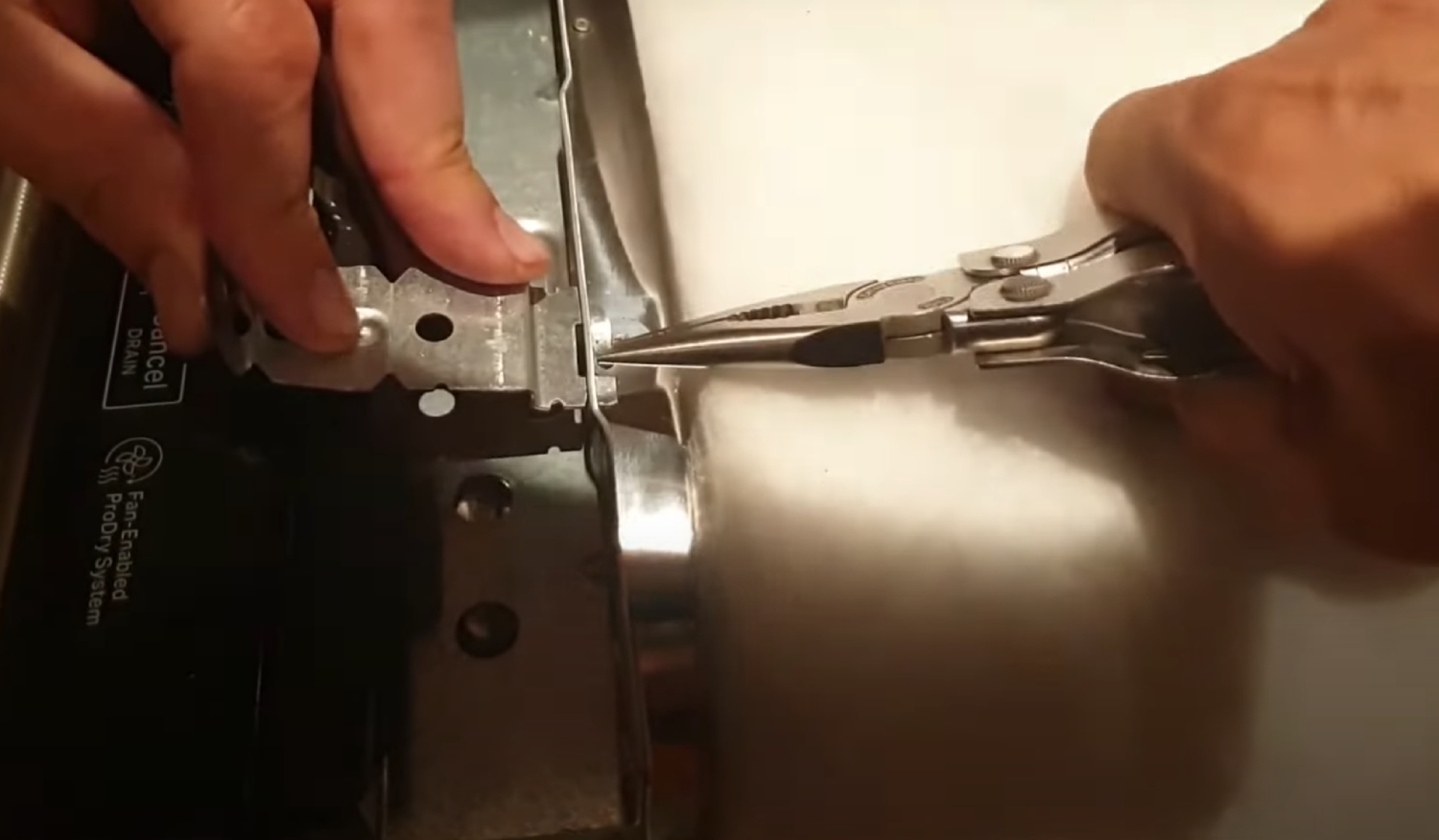How to Install Dishwasher Brackets: A Homeowner’s Guide
To install dishwasher brackets, start by turning off the power and shutting off the water supply. Remove screws from the access panel and disconnect the water line, drain hose, and electrical connections. Carefully pull out the dishwasher. Position the new mounting bracket under the countertop, securing it to the cabinets with a screwdriver.
Slide the dishwasher back into place, ensuring it’s aligned with the bracket, and reconnect the drain hose. Don’t forget to re-establish electrical connections safely. Finally, test the installation by running a short cycle to check for leaks and proper functionality. Want to know more about securing your installation?
Key Takeaways
- Turn off power and water supply before starting the installation to ensure safety and prevent leaks.
- Remove the existing dishwasher by detaching connections and securing screws to facilitate access for the new bracket.
- Install the new mounting bracket under the countertop, ensuring it is aligned and securely fastened to the cabinets.
- Reconnect the drain hose and water supply line, ensuring all connections are tight to prevent leaks.
- Test the installation by running a short cycle, checking for leaks and verifying proper functionality.
Preparation for Installation
Before you plunge into installing dishwasher brackets, there are a few essential preparations to tackle.
First things first, make sure the power supply to your dishwasher is turned off. This step’s critical for preventing any electrical hazards during installation.
Next, shut off the water supply valve to avoid any unwanted leaks while you work.
Now, gather your tools. You’ll need channel lock pliers, a 5/16 inch socket or nut driver, and a Philips head screwdriver. Having these handy will make the process much smoother.
Once you’ve got everything ready, use a 1/4 inch socket or nut driver to remove the screws from the lower access panel. This will allow you to access the internal components of your dishwasher.
Don’t forget to take out the access panel along with any insulation present. This preparation is essential as it clears the area for the installation of the new mounting bracket.
Disconnecting Existing Connections
Disconnecting existing connections is a crucial step in preparing your dishwasher for bracket installation. Start by using channel lock pliers to unthread the water supply line from the inlet valve. Be cautious, as this may lead to some water spillage.
Next, carefully remove the junction box cover with a 5/16-inch socket or nut driver. Make sure to note the wire locations, as you’ll need to reconnect them later.
Once the cover is off, detach the strain relief from the junction box by unthreading the securing nut. This will give you easier access to the wiring.
Don’t forget to disconnect the drain hose from the sink or garbage disposer, making sure that the hose is fed through the cabinet to allow for smooth removal.
Before you pull the dishwasher out, double-check that all connections are properly disconnected. This precaution helps prevent any damage to the appliance or plumbing.
Taking your time with these steps will guarantee a smoother installation process and a hassle-free experience as you move on to the next phase of your dishwasher bracket installation.
Removing the Dishwasher
Removing the dishwasher is a straightforward process, but it requires attention to detail to avoid any mishaps.
Start by disconnecting the drain hose from the sink or garbage disposer. This step is essential for preventing any water spills during removal. Carefully feed the drain hose through the cabinet to fully detach it from the plumbing.
Next, open the dishwasher door and locate the screws securing the mounting bracket to the underside of the countertop. Remove these screws to free the dishwasher from its mount. If necessary, adjust the legs of the dishwasher to lower the appliance, which can make it easier to pull out.
Now it’s time to gently pull the dishwasher away from the cabinet. Make sure to do this slowly and carefully, ensuring you don’t damage the surrounding cabinetry or plumbing connections.
Keep an eye on any electrical cords or water lines as you maneuver the dishwasher out. Once you’ve safely removed it from its space, you’re ready for the next steps in your kitchen project.
Installing New Mounting Bracket
With the dishwasher successfully pulled out, you can now focus on installing the new mounting bracket. This step is essential for securing your dishwasher and preventing any movement. Follow these simple steps for a smooth installation:
- Prepare the Bracket: Start by folding down the end tabs of the universal mounting bracket. This guarantees a snug fit under the countertop.
- Seal the Bracket: Apply silicone to the raised sections of the bracket. This creates a watertight seal and helps prevent any potential leaks.
- Position and Fasten: Position the bracket directly under the countertop, making sure it aligns properly with your cabinetry. Use a Philips head screwdriver to securely fasten the bracket to the cabinets, making sure it’s tightly anchored.
Before wrapping up, double-check that the drain hose end is accessible through the cabinet wall. This will make future connections much easier.
Securing the Dishwasher
Now that you’ve installed the mounting bracket, securing your dishwasher is the next essential step to verify it operates safely and efficiently. Start by confirming the universal mounting bracket is properly prepared; fold down the end tabs for a snug fit. Next, apply silicone to the raised sections of the bracket to create a secure seal against the countertop.
Position the bracket under the countertop, and use a Philips head screwdriver to tighten it securely to the cabinets. After that, slide your dishwasher back into the cabinet, confirming it aligns with the bracket. Use the provided screws to attach it securely to the new mounting bracket.
Finally, double-check that the drain hose end is accessible through the cabinet wall, which is imperative for proper drainage.
Here’s a quick overview of the steps:
| Step | Action | Tools Needed |
|---|---|---|
| 1. Prepare Bracket | Fold down end tabs | None |
| 2. Seal Mounting Bracket | Apply silicone | Silicone |
| 3. Position Bracket | Secure under the countertop | Philips head screwdriver |
| 4. Slide Dishwasher Back | Align with bracket | None |
| 5. Check Drain Hose Access | Verify accessibility | None |
Reconnecting the Drain Hose
Reconnecting the drain hose is an essential step in making certain your dishwasher functions effectively and avoids any potential leaks. Follow these simple guidelines to guarantee a successful connection:
- Feed the Hose Properly: Make sure the drain hose is adequately fed through the cabinet, keeping it free from kinks or bends that could obstruct water flow.
- Connect Securely: Attach the drain hose to the sink drain or garbage disposer, ensuring a snug fit to prevent leaks.
- Use a Hose Clamp: Don’t forget to secure the drain hose connection with a hose clamp. Tighten it with a screwdriver for added security.
Additionally, position the drain hose higher than the dishwasher’s drain outlet to prevent backflow of wastewater.
After everything’s connected, it’s time to test your work. Run a short cycle on the dishwasher to check for leaks and make certain proper drainage functionality.
Re-establishing Electrical Connections
Before you can enjoy the convenience of your newly installed dishwasher, it’s important to re-establish the electrical connections safely. First, make sure the power to the dishwasher is completely turned off. This step is critical to prevent any electrical hazards while you work.
Next, take a moment to carefully note the original wire locations and connections before you untwist the wire nuts. This will help guarantee you reconnect everything correctly.
Position the wire strain relief back into the junction box and secure it with the nut. This prevents any strain on the electrical wires, which could cause future issues.
Now, it’s time to reconnect the wires. Match the colors: typically, black connects to black, white to white, and green or bare wire goes to the ground. Twist the wires together with wire nuts, making sure they’re secure.
Once all connections are made, replace the junction box cover using a 5/16-inch socket or nut driver. This final step is significant for safety and compliance with electrical codes.
Testing the Installation
Now that you’ve secured your dishwasher, it’s time to test the installation.
Start by checking the leveling adjustments to guarantee it sits evenly, then inspect all connections for stability and leaks.
Check Leveling Adjustments
Once you’ve secured the dishwasher brackets, it’s essential to check the leveling adjustments to guarantee your appliance is functioning properly.
A level dishwasher guarantees that it operates efficiently and prevents leaks. Here’s how to check and adjust it:
- Use a Bubble Level: Place a bubble level on top of the dishwasher. Make sure it’s perfectly horizontal. This is key for proper operation.
- Adjust Leveling Legs: If the level indicates it’s off, adjust the leveling legs. Turn them clockwise to raise the dishwasher or counterclockwise to lower it until it’s level.
- Test Stability: Gently push on the front of the dishwasher. It should feel stable and not rock or move if it’s secured correctly.
Once you’ve made the adjustments, run a short cycle to confirm everything operates smoothly without any leaks.
This step verifies your installation is successful, providing peace of mind that your dishwasher is set up correctly and ready to handle your cleaning tasks.
Inspect Secure Connections
After verifying your dishwasher is level and stable, it’s time to inspect the secure connections to confirm everything’s installed correctly. Start by checking that all screws holding the dishwasher to the brackets are tightened. A wobbly appliance can lead to bigger issues down the line.
Next, test the stability of your dishwasher. Gently push against it from different angles; it should remain firmly in place without any movement. This step is essential for preventing future problems. Also, inspect the mounting bracket’s alignment with the countertop. Misalignment can create gaps that may result in water leakage or instability.
You’ll also want to verify that the drain hose is properly routed and secured. Make sure there are no kinks or blockages that could impede water drainage. Finally, conduct a thorough inspection of all connections, including the water supply line and electrical junction box, to confirm they’re tightly secured and free of leaks or loose wires.
| Connection Type | Inspection Criteria | Action Needed |
|---|---|---|
| Dishwasher Brackets | Screws tightened, no wobble | Tighten screws |
| Drain Hose | No kinks or blockages | Adjust hose routing |
| Water Supply Line | No leaks, securely connected | Tighten connections |
| Electrical Junction | Wires secure, no loose connections | Re-secure wires |
Test Water Supply
Testing the water supply is an essential step in guaranteeing your dishwasher is properly installed and functioning. Follow these simple steps to confirm everything’s in order:
- Check for Leaks: Turn the water supply valve back on slowly after securing all connections. Look for any leaks at the water supply line connection.
- Run a Cycle: Start a short cycle on the dishwasher. This helps verify that it’s working correctly and that the water drains properly without blockages.
- Inspect for Issues: While the cycle runs, keep an eye on the drain hose connection to the sink or garbage disposer. Look for any signs of leaks, and listen for unusual noises that might indicate installation problems.
After the cycle, monitor the area around your dishwasher for a few minutes. You want to guarantee no water accumulates, which could signal a potential installation issue.
Final Checks and Adjustments
Before you start using your newly installed dishwasher, it’s crucial to carry out a few final checks and adjustments. First, confirm your dishwasher is level by adjusting the leveling legs to prevent vibrations during operation. Next, check that the drain hose is properly positioned and free of kinks to allow for efficient drainage and prevent clogs.
Confirm that all connections, including the water supply line and electrical junction box, are securely fastened to avoid leaks or electrical issues. After that, perform a test run of the dishwasher to verify it operates correctly and there are no leaks from the water supply or drain connections. Finally, inspect the mounting bracket and screws to confirm they’re tightly secured, providing stability and preventing movement during use.
Here’s a handy checklist to guide you through these final checks:
| Check | Action Required | Status |
|---|---|---|
| Leveling legs | Adjust if necessary | [ ] Done |
| Drain hose | Confirm it’s kink-free | [ ] Done |
| Connections secured | Tighten all connections | [ ] Done |
| Test run | Run a cycle and check for leaks | [ ] Done |
Frequently Asked Questions
How to Install Dishwasher Side Mounting Brackets?
To install dishwasher side mounting brackets, first fold the end tabs for a snug fit. Then secure them under the countertop with silicone for stability, ensuring everything’s flush before sliding the dishwasher back into place.
How to Anchor a Dishwasher to a Quartz Countertop?
To anchor your dishwasher to a quartz countertop, secure a universal bracket beneath it, apply silicone for moisture protection, and fasten it to cabinetry. Finally, slide the dishwasher in and attach it firmly.
How Should a Dishwasher Be Mounted?
To mount your dishwasher, secure the universal mounting bracket to the countertop. Apply silicone for a watertight seal, level the dishwasher, and use screws to attach it to the cabinets for stability during operation.
How to Anchor a Dishwasher to the Side of Cabinets?
Isn’t it essential to anchor your dishwasher securely? Align the mounting bracket with cabinet sides, fasten it tightly with a screwdriver, and check the stability. This prevents wobbling and guarantees safe operation during use.
Your Kitchen, Your Effort: The Joy of DIY Dishwasher Success
Now that you’ve successfully installed your dishwasher brackets picture the seamless flow of clean dishes gliding effortlessly into your sparkling kitchen. You’ve transformed an intimidating task into a triumph, ensuring everything is secure and ready for use.
As you stand back and admire your handiwork, you can almost hear the gentle hum of your dishwasher, a proof of your hard work. With every cycle, you’ll feel the satisfaction of knowing you did it yourself. Enjoy your fresh start.







